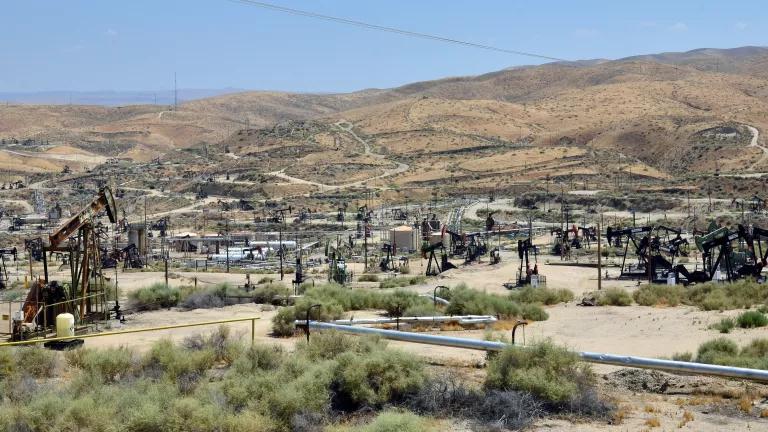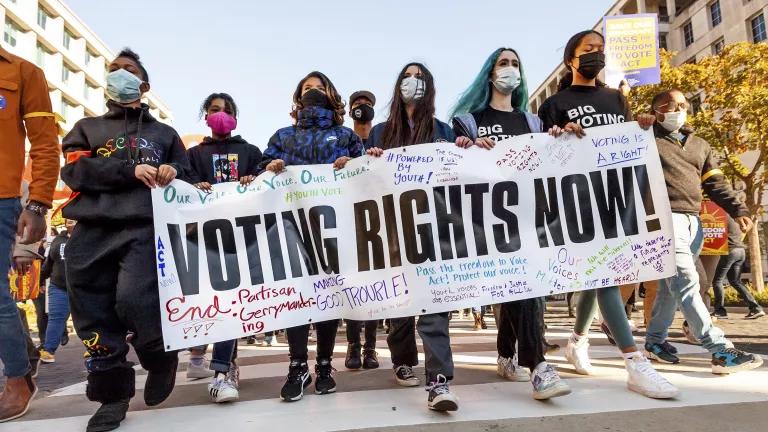Lawsuit Filed Over Plans to Frack the Golden State
For literally about the hundredth time, we’re suing the Trump Administration over its attacks on the environment. This time around, we’re defending California against the Administration’s plans to frack it.

Southern California oil field
For literally about the hundredth time, we’re suing the Trump Administration over its attacks on the environment. This time around, we’re defending California—which as a Californian I’m proud to say is Trump’s least favorite state—against the Administration’s plans to frack it.
Last spring, as described in an earlier post, the federal Bureau of Land Management (BLM) took steps to open up more than a million acres of public land and mineral rights to oil drilling in Southern California. BLM had issued a draft supplemental environmental impact statement (EIS) evaluating the plan, following a 2017 court ruling that their first attempt at an EIS failed to consider the impacts of fracking. As required by law, BLM took public comments on the draft before issuing the final.
To the surprise of absolutely no one who’s been paying attention, the final looked pretty much just like the draft, with no significant changes made in response to the roughly 16,000 written public comments BLM received—a good number of them (including those from NRDC and its coalition partners) full of detailed data regarding the severe technical deficiencies in the EIS analysis.
What did catch us by surprise—although perhaps it shouldn’t have given the depths to which federal environmental policy has descended—was the sheer thumb-in-your-eye lameness of the response to public comments that accompanied the final supplemental EIS. The law takes public comment seriously, requiring that the agency either make changes to address the comments or else provide a solid explanation why not. While we’re not always happy with how BLM and other agencies respond to our comments, the responses generally rise at least to a level of solid bureaucratic mediocrity, providing facts to support the agency’s view that they’re right and we’re wrong.
Not this time. What we got instead was a set of about half a dozen one-paragraph canned responses, which were repeated for a space of nearly 400 single-spaced pages, attached again and again to thoughtful comments largely unrelated to the nebulous text of the canned answer. It resembled nothing so much as the Magic 8 Ball toy of my boomer childhood, which when shaken provides one of a set of brief vague responses (like “outlook good” “ask again later” or “don’t count on it”) that are only occasionally relevant by accident.
For example, BLM provided this response—stating that it would wait until it actually leased the land to fracking developers before considering our concerns—more than 250 times:
The environmental review for leasing identifies parcels to be offered for leasing and the conditions under which leasing and eventual development may occur. The environmental review, including direct and indirect effects, for the development of leased parcels, including well completion techniques such as hydraulic fracturing, is a site specific analysis of potential impacts from an identified proposed project. Applications for Permits to Drill (APDs) are required to be submitted by developers/operators, and typically include an initial on-the-ground, site-specific field evaluation by BLM resource specialists in addition to a site-specific NEPA analysis. This analysis allows site-specific information regarding local resource conditions to be evaluated and potential impacts disclosed. During this project-specific analysis, BLM would finalize the set of design features, Conditions of Approval (COAs), BMPs, and stipulations from the 2014 RMP that would be applied to the project.
That’s basically “ask again later” in a few more words. This response (with a couple introductory sentences not quoted here) was applied even to comments that clearly pertain to cumulative impacts of issuing multiple leases across a million-plus acres, such that a reference to a future evaluation of individual leases is unresponsive. In some cases, BLM attached a canned response that didn’t even refer to the right statute—for instance, where commenters explained how BLM hadn’t complied with the Endangered Species Act, BLM responded with the same few lines about how it had complied with the National Environmental Policy Act.
Unfortunately, BLM’s belligerently obtuse approach to our comments fits right in with the tone of the President’s larger determination to smack around the Golden State in whatever way he can—from bizarre tweets about the need to sweep California’s forest floors to legal action to block bedrock parts of California’s stringent automobile emissions and climate pollution laws.
California, however, is not in the habit of taking that sort of thing lying down, and neither are NRDC and its partners. California Attorney General Xavier Becerra took the unusual step of publicly blasting BLM after it issued the final supplemental EIS, stating, “The Trump Administration’s Bureau of Land Management wants to expose more than a million acres of public land in Central California to drilling and fracking using a patently deficient environmental impact study…That’s not how we do things in California. We’re prepared to do whatever we must to protect the health and safety of our people. We intend to be good stewards of our public lands.” And NRDC filed its lawsuit against BLM today, represented by Earthjustice attorneys, together with a broad array of partner organizations including the Sierra Club, the National Parks Conservation Association, The Wilderness Society, the Central California Environmental Justice Network, Los Padres ForestWatch, and the Center for Biological Diversity (representing several plaintiff organizations as well as the outdoor recreational clothing company Patagonia Works).
Ask the Magic 8 Ball whether we’ll win this round, and you may get “cannot predict now.” But ask whether we’ll keep fighting as hard as possible for California and the nation’s public lands, and if the thing is working right you’ll get “it is certain.”



